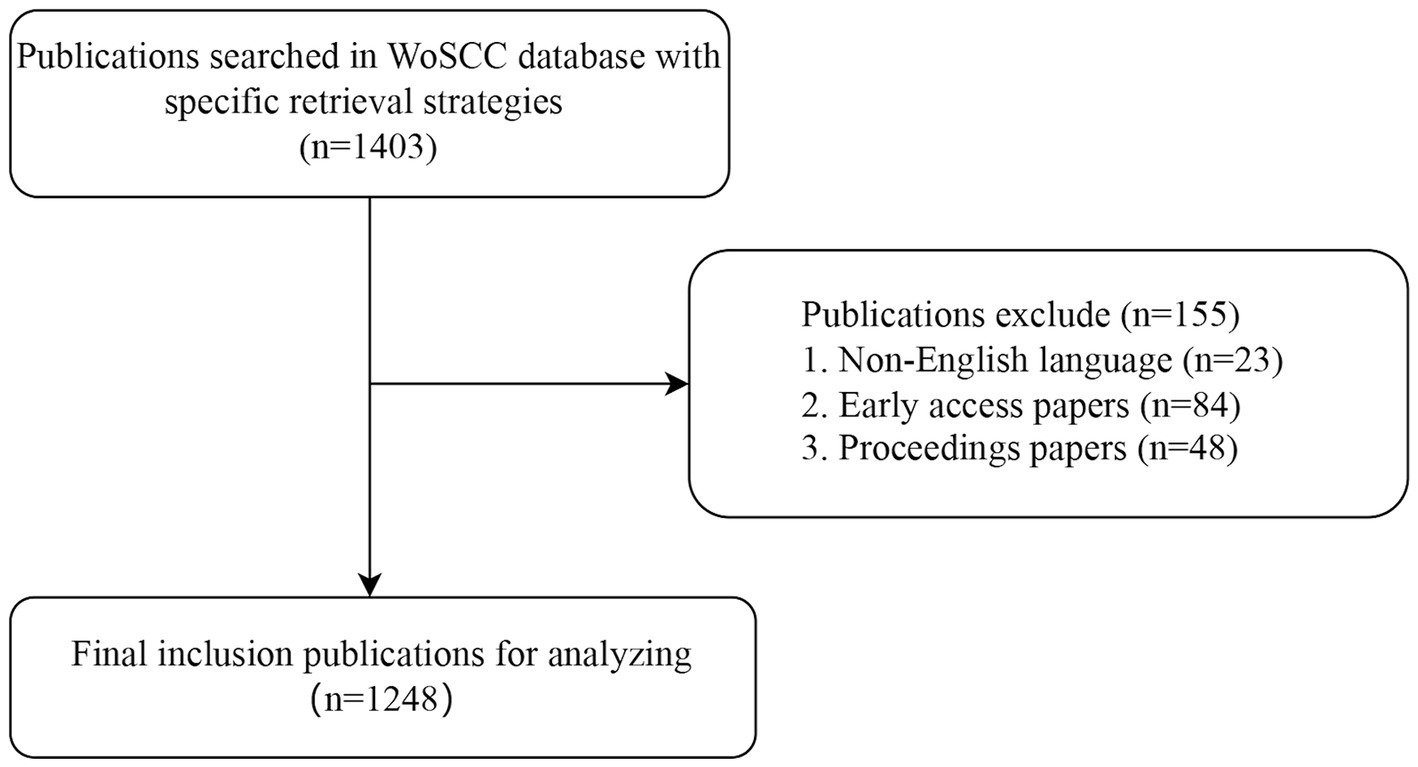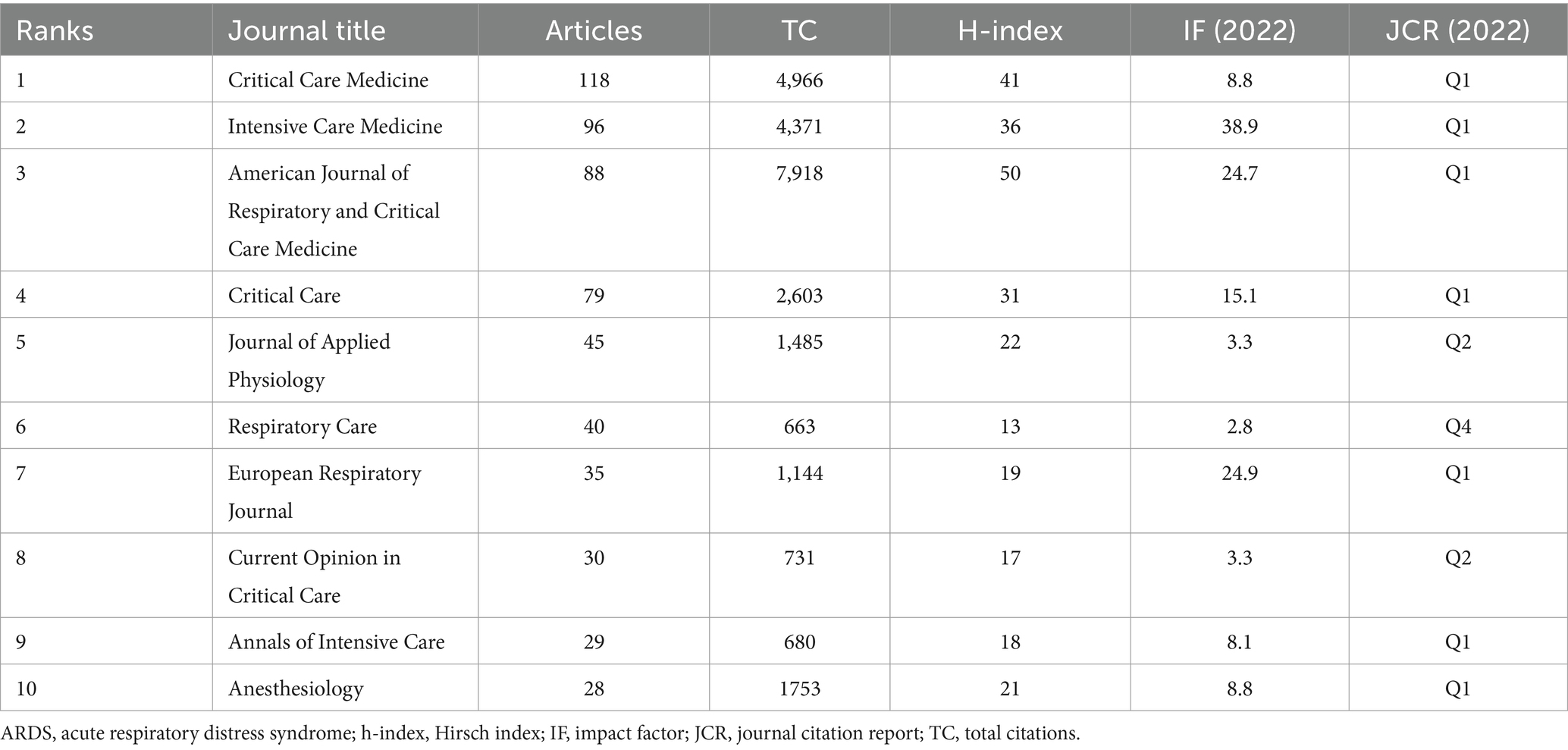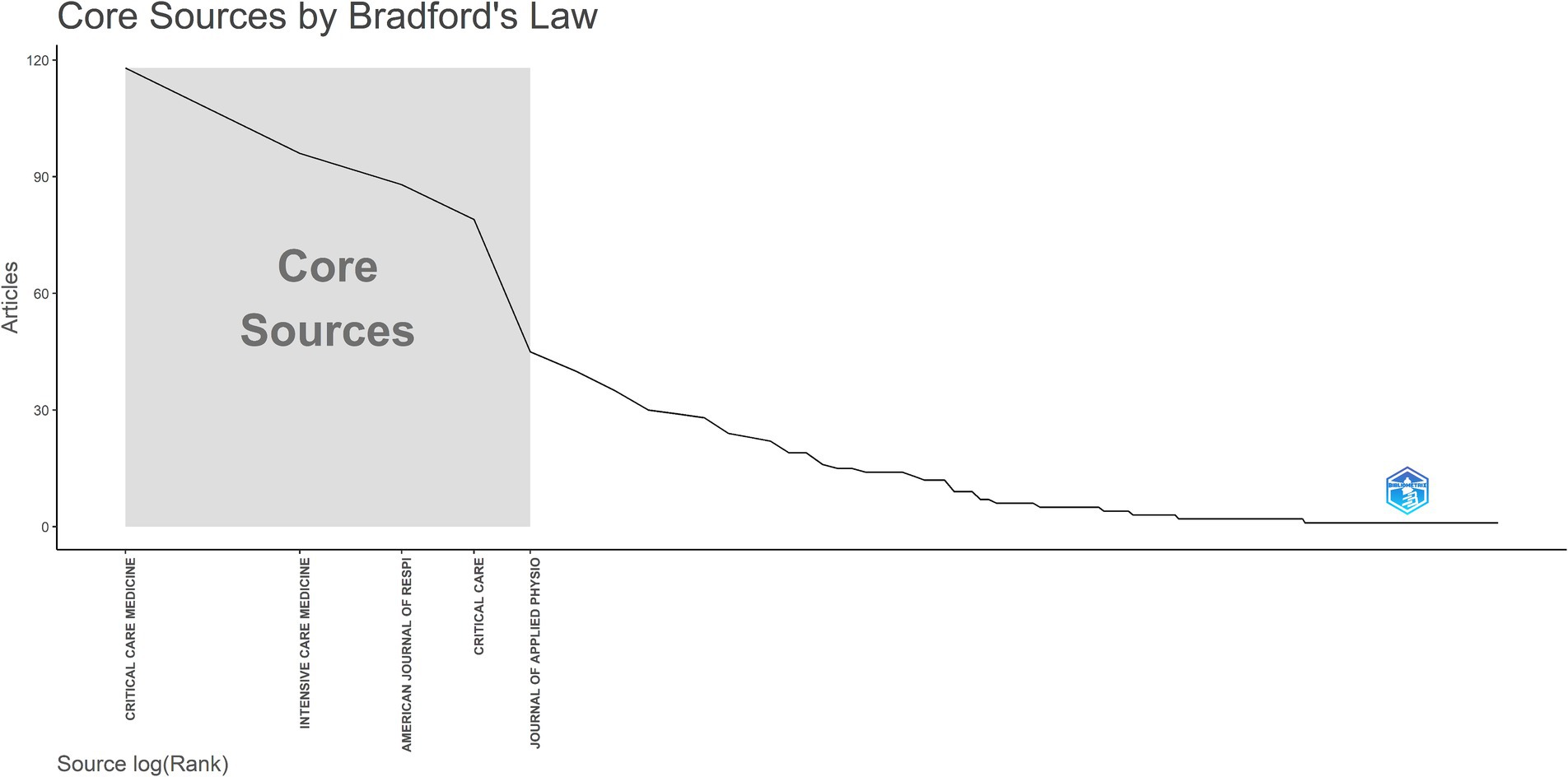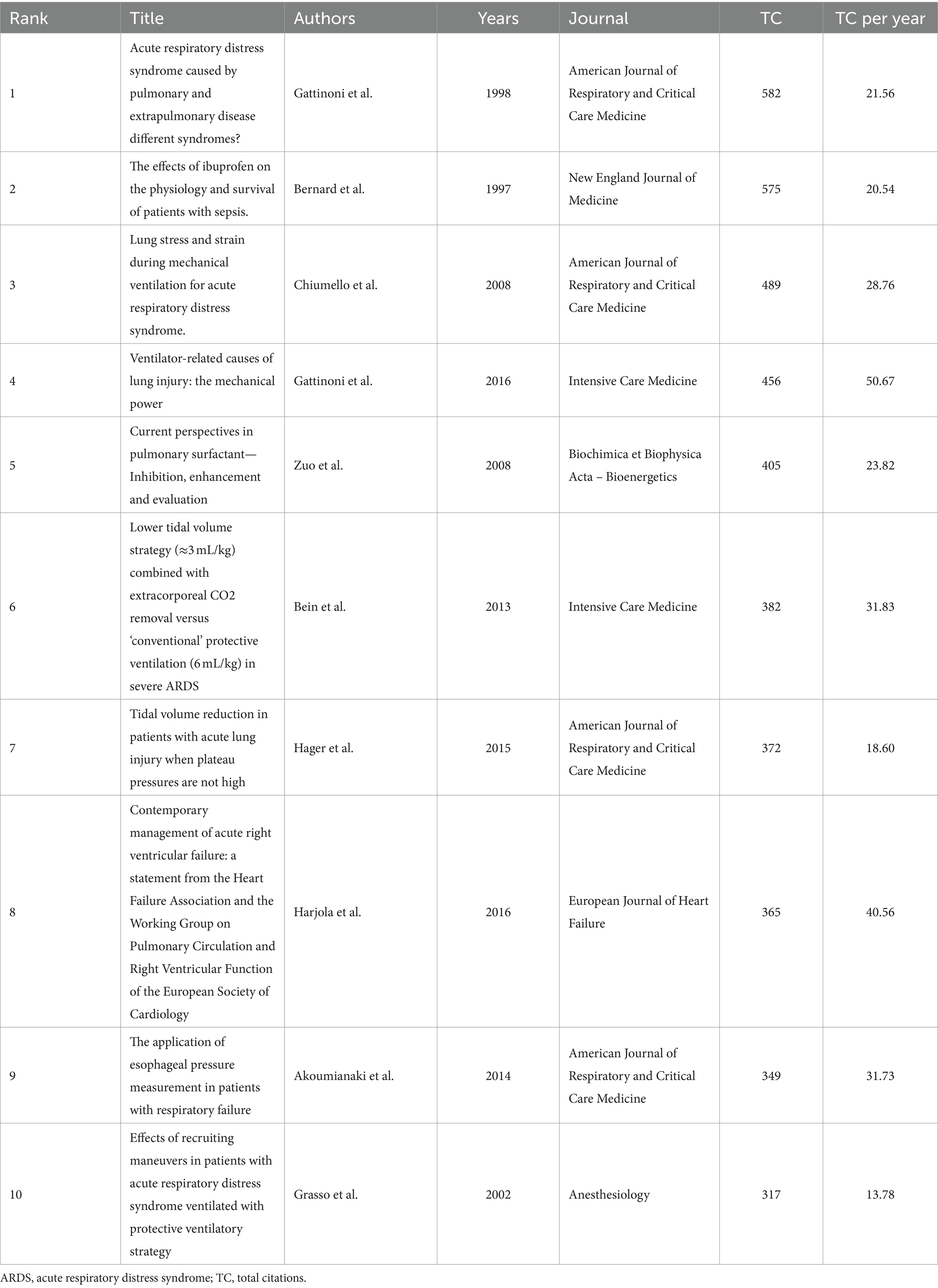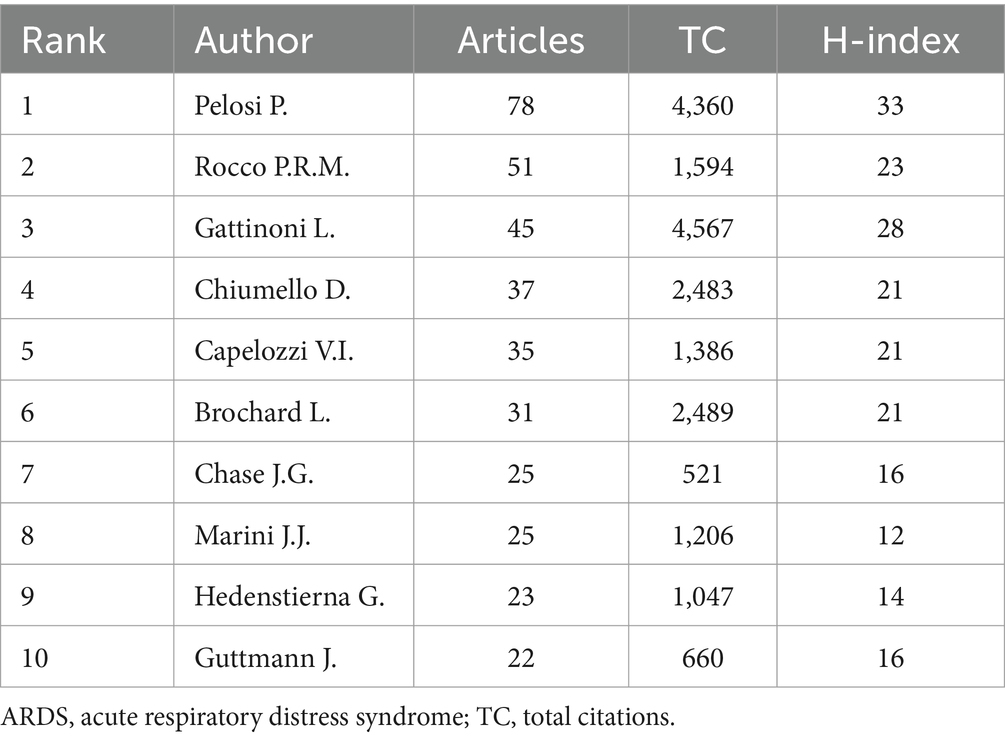- 1Department of Critical Care Medicine, Beijing Tiantan Hospital, Capital Medical University, Beijing, China
- 2Department of Respiration, Liaocheng People’s Hospital, Liaocheng, China
- 3Department of Critical Care Medicine, Beijing Shijitan Hospital, Capital Medical University, Beijing, China
Background: Acute respiratory distress syndrome (ARDS) is a severe condition characterized by lung stiffness and compromised gas exchange, often requiring mechanical ventilation for treatment. In addition to its clinical significance, understanding the publication trends and research patterns in respiratory mechanics related to ARDS can provide insights into the evolution of this field from a bibliometric perspective, aiding in strategic planning and resource allocation for future research endeavors.
Objective: This study aimed to explore the trends and identify the hotspots in respiratory mechanics research related to ARDS.
Methods: All relevant studies on respiratory mechanics of ARDS published between 1985 and 2023 were retrieved from the Web of Science Core Collection (WoSCC), and the retrieval strategy was topic search “TS = respiratory mechanics OR lung mechanics AND TS = ARDS OR acute respiratory distress syndrome.” Annual trends, citation patterns, and contributions from countries, institutions, authors, and journals were analyzed using Bibliometrix Biblioshiny. Networks and overlay of authors, institutions, countries, journals, co-citations, and keywords were analyzed and visualized using VOSviewer.
Results: Our analysis included 1,248 articles published between 1985 and 2023, revealing fluctuations in publication output over time. The United States emerged as the leading contributor, with Critical Care Medicine being the most prominent journal. Key research themes included mechanical ventilation, acute lung injury, and protective ventilation strategies. International collaboration was evident, facilitating knowledge exchange and interdisciplinary cooperation.
Conclusion: Our study sheds light on the evolving landscape of respiratory mechanics research in ARDS. International collaboration is pivotal in advancing the field, while researchers increasingly focus on personalized approaches to address the complexities of ARDS respiratory mechanics.
Introduction
Since its first description in 1967, acute respiratory distress syndrome (ARDS), characterized by stiff lungs and a “baby lung”, has been researched for over 55 years (1, 2). Over the past five decades, several milestones have shaped our understanding and treatment of ARDS (3). Notably, the introduction of the American–European Consensus Conference definition in 1994 standardized the diagnosis and significantly influenced clinical trials and practice. The subsequent Berlin Definition in 2012 further refined ARDS classification, leading to a resurgence in research focused on this syndrome (4). The new global definition of ARDS proposed in 2024 further expands the definition of ARDS, promoting its early recognition and diagnosis and ensuring that patients with ARDS in resource-limited areas are no longer excluded (5). Despite these advancements, the mainstay of therapy remains mechanical ventilation, which, while life-saving, can also cause iatrogenic lung injury if not carefully managed (6–8). The recognition of ventilator-induced lung injury (VILI), the development of lung-protective strategies, such as the use of low tidal volumes and appropriate positive end-expiratory pressure (PEEP), and prone position ventilation represent critical advancements in ARDS management (9–11). In this scenario, respiratory mechanics plays an essential role in ARDS management. First, mechanics variables such as respiratory system compliance, driving pressure, and mechanical power were considered markers of the severity of ARDS and contributed to a better understanding of its pathogenesis (12, 13). Second, respiratory mechanical parameters can guide individualized mechanical ventilation therapy in ARDS patients, reducing the risk of ventilator-associated lung injury and enabling the evaluation of therapeutic effects through bedside monitoring (14–16).
The widespread application and popularity of the Internet have led to an explosive increase in the publication and citation volume of medical literature (17). Bibliometric analysis, a well-established and widely recognized research method, is frequently used to quantify the impact of scientific articles and evaluate contributions to a research field, including those by countries, institutions, authors, and journals (18). Through information visualization and bibliometric analysis, this method can also reveal trends in temporal changes and research hotspots in a specific research field (19, 20). At present, it has been widely used in medical research on sepsis (21), nursing (22), and stomatology (23). Despite the existence of a limited number of bibliometric analysis studies in the field of ARDS, to our knowledge, no bibliometric studies have focused explicitly on ARDS’s respiratory mechanics (24–26). Therefore, our study fills this gap and offers a unique perspective on the field.
In this study, we conducted an exhaustive bibliometric analysis of literature on ARDS-related respiratory mechanics, encompassing the annual number of publications, countries, journals, authors, international cooperation, and institutions analysis. Furthermore, overlay visualization maps of co-occurring keywords and clustering analysis were performed to identify the trends and hotspots of respiratory mechanics research related to ARDS. This study offers a new perspective and serves as a foundation for future research on ARDS-related respiratory mechanics.
Methods
Data sources and search strategies
All data for this study were retrieved from the Web of Science Core Collection (WoSCC) via the Capital Medical University Library website. The retrieval strategy was “[TS = (respiratory mechanics OR lung mechanics)] AND [TS = (ARDS OR acute respiratory distress syndrome)].” The publication period was between 1985 and 2023. Publications in languages other than English were excluded. All searches were conducted on 6 June 2024 to avoid bias in database updates. WoSCC data, including titles, authors, institutions, countries, journals, abstracts, keywords, and references, were downloaded in plain TXT format. Data collection was performed online, and ethical approval was not required. Two investigators (ZYM and WYM) independently performed the searches, demonstrating significant consistency (κ = 97%).
Bibliometric analysis and visualization
The raw data were imported to Bibliometrix Biblioshiny, an online platform of literature metrology, for bibliometric analysis (27). VOSviewer 1.6.19 (Leiden University, Leiden, The Netherlands) was used to analyze and visualize networks and overlay of authors, institutions, countries, journals, co-citations, and keywords (28).
Results
A total of 1,403 articles related to respiratory mechanics of ARDS published between 1985 and 2023 were initially identified. After excluding 23 non-English-language publications, 84 early access articles, and 48 proceedings articles, 1,248 publications were ultimately analyzed (Figure 1).
Annual tendencies and citations
Figure 2 illustrates the annual trends in publications related to the respiratory mechanics of ARDS. The number of articles published each year varied, with notable peaks observed in 2020 and 2021, during which 75 articles were published each year, constituting 6.0% of the total publications. The total number of articles cited during the entire period covered by the data was 40,272, with an average citation count of 32.27 per article. From 1992 to 2005, the number of articles remained relatively stable, followed by a significant increase, especially between 2012 and 2021.
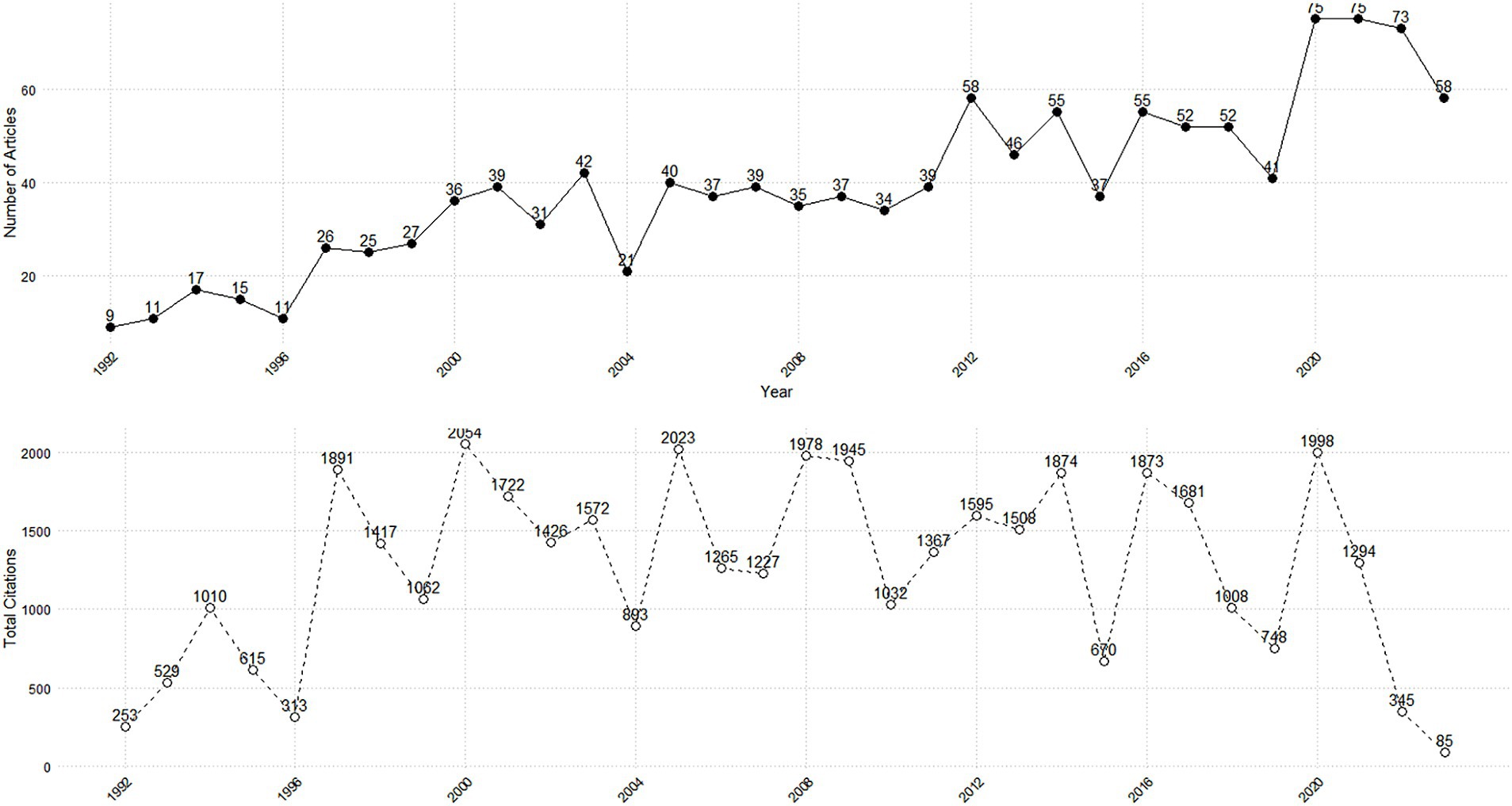
Figure 2. Annual trends in publications (upper panel) and citations (bottom panel) related to the respiratory mechanics of ARDS.
Contribution of countries and institutions
Between 1985 and 2023, 45 countries or regions and 1,316 institutions contributed to publications on the respiratory mechanics of ARDS. The top 10 countries or regions and the top 10 institutions are presented in Tables 1, 2. The United States emerged as the most significant contributor, with 296 articles published, followed by Italy (n = 165), Germany (n = 115), China (n = 88), France (n = 79), Brazil (n = 62), Canada (n = 58), Sweden (n = 39), Spain (n = 36), and Greece (n = 26). The Federal University of Rio de Janeiro led in productivity with 126 articles published, followed by the University of Milan (n = 112), University of Toronto (n = 99), University of São Paulo (n = 86), Harvard University (n = 59), University of Genoa (n = 52), University of California, San Francisco (n = 49), Uppsala University (n = 43), Massachusetts General Hospital (n = 40), and University of Minnesota (n = 37).
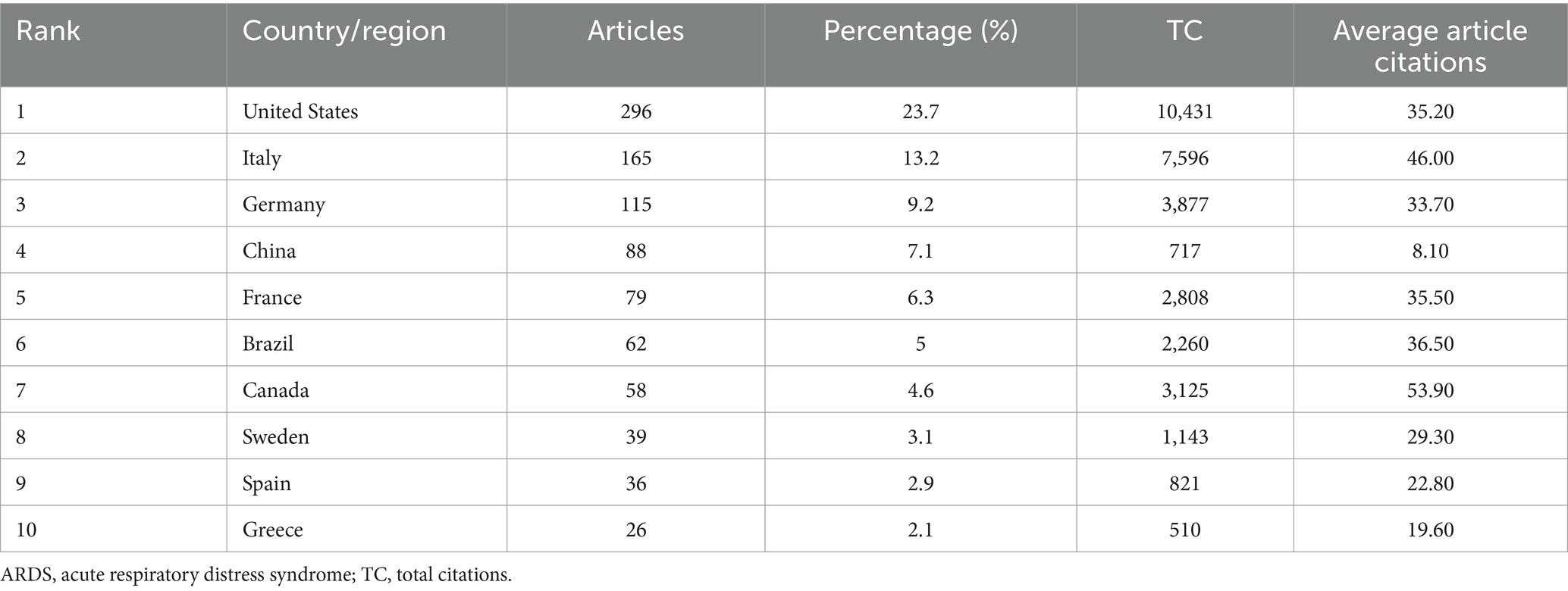
Table 1. The top 10 countries/regions contributing to publications on respiratory mechanics of ARDS.
VOSviewer software generated a collaboration network based on countries and institutions. As depicted in Figures 3A,B, close cooperation among research institutions from various countries was observed during the research period. The international cooperation analysis revealed that the United States was the most frequently involved in global collaborations, while the University of Milan was the most commonly engaged institution in international partnerships.
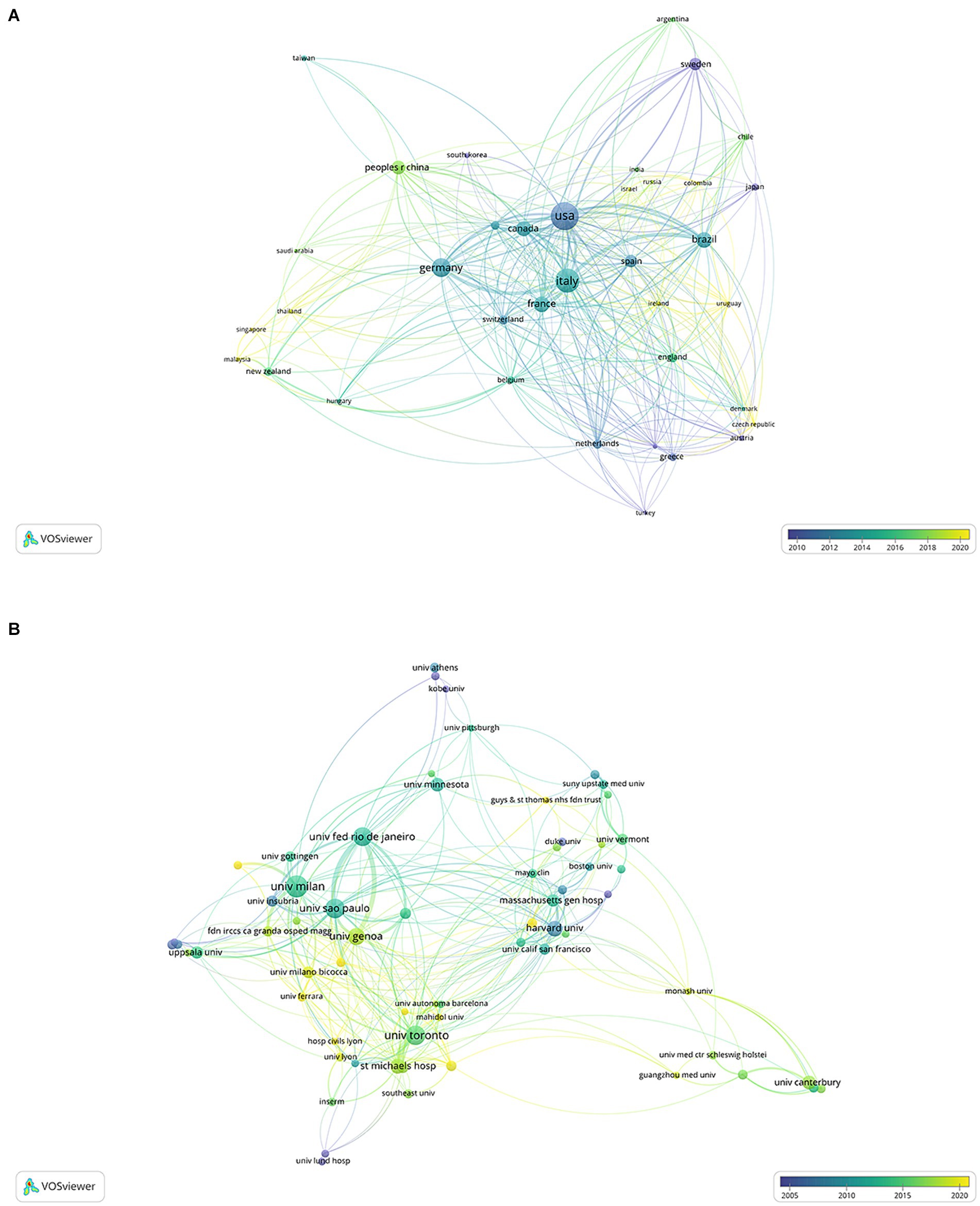
Figure 3. Co-authorship overlay visualization map of countries (A) and institutions (B). The color of each circle corresponds to the average publication year, the size of a circle is proportional to the volume of literature, and the thickness of the connecting line indicates the cooperation frequency.
High-yielding journals and the most influential articles
Until 31 December 2023, 1,248 publications on research linked to respiratory mechanics of ARDS were published in 235 journals, of which 48 contained at least 5 publications. The top 10 high-yielding journals are listed in Table 3, along with their publication counts, total citations, Hirsch index (h-index), Impact Factor in 2022 (IF 2022), and quartile in the category in 2022 (JCR 2022). Critical Care Medicine is the most prolific journal in this field with 118 publications, although its IF 2022, h-index, and total citations are not the highest. Intensive Care Medicine (n = 96) has the highest IF in 2022, and the American Journal of Respiratory and Critical Care Medicine (n = 88) has the highest h-index among the top 10 high-yielding journals. Other notable journals included Critical Care (n = 79), Journal of Applied Physiology (n = 45), Respiratory Care (n = 40), European Respiratory Journal (n = 35), Current Opinion in Critical Care (n = 30), Annals of Intensive Care (n = 29), and Anesthesiology (n = 28). According to Bradford’s law, five journals were in the core field (Figure 4). The top 10 most highly cited publications are listed in Table 4.
Contribution of authors
The top 10 most productive authors in respiratory mechanics research related to ARDS are presented in Table 5. Pelosi P from the Department of Anesthesia and Intensive Care, San Martino Policlinico Hospital in Italy, ranks first with 78 articles published and has the highest h-index. The top 3 authors with the most citations are Gattinoni L, Pelosi P, and Brochard L (4,567 vs. Four,360 vs. Two,489 times, respectively, Table 5).
A co-authorship overlay visualization map was generated using VOSviewer software, with a threshold set to a minimum of 10 documents per author. Finally, 62 authors who met the threshold were identified. As shown in Figure 5A, Pelosi P has the broadest range of collaborations, with a total of 25 links, followed by Gattinoni L (n = 19), Chiumello D (n = 19), and Brochard L (n = 17). A co-citation overlay visualization map was also generated, with the threshold set to a minimum of 500 citations per author. Finally, 34 authors who met the threshold were identified. It is evident from the visualization that Pelosi P and Gattinoni L have made significant contributions to respiratory mechanics in ARDS (Figure 5B).
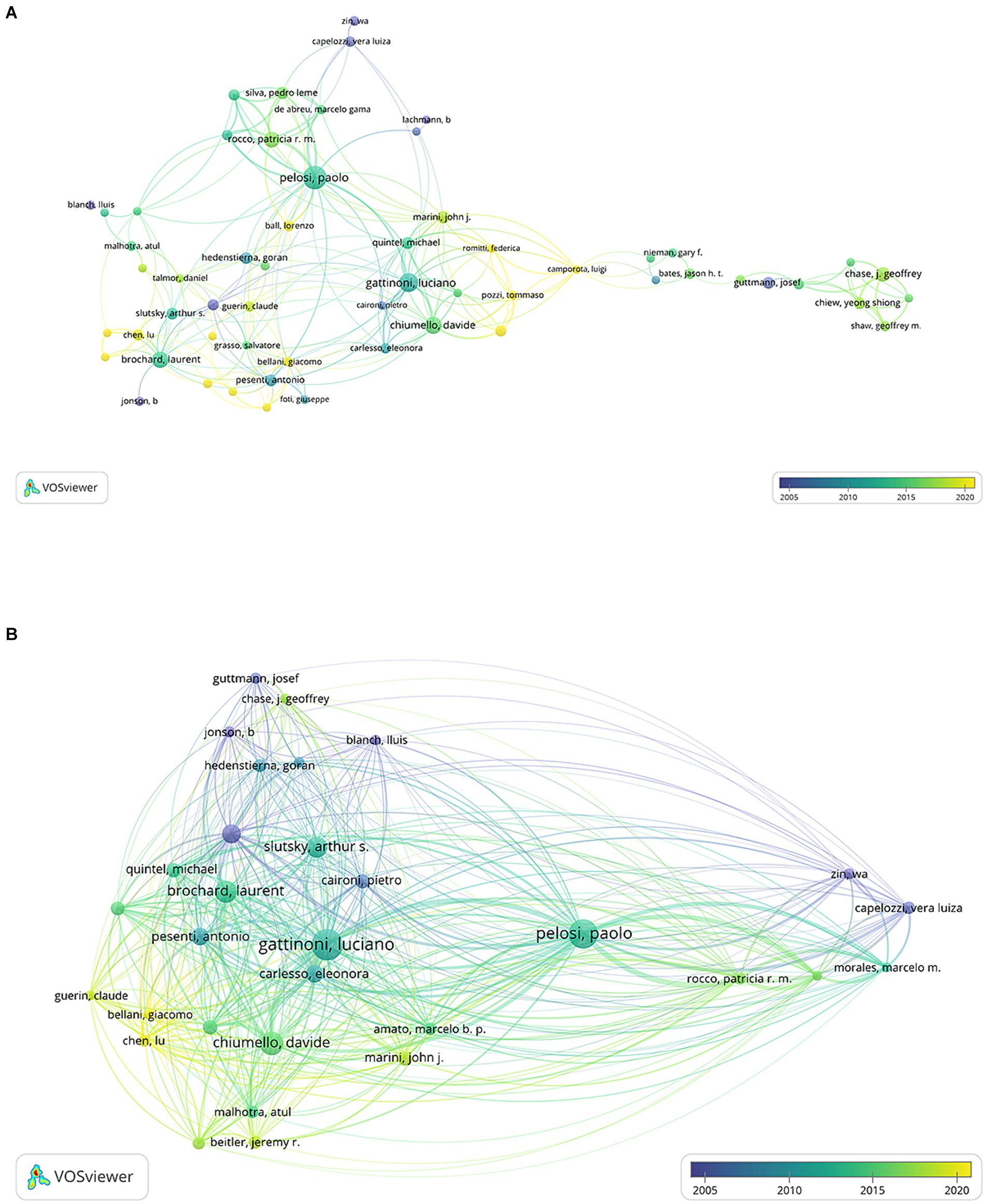
Figure 5. The distribution of authors in respiratory mechanics of ARDS research. (A) Co-authorship overlay visualization map of authors. The color of each circle corresponds to the average publication year of the author, the size of a circle is proportional to the number of literature, and the thickness of the connecting line indicates the strength of the co-occurrence link. (B) Co-citation overlay visualization map of authors. The color of each circle corresponds to the average publication year of the author, the size of a circle is proportional to the total number of citations of the author, and the thickness of the connecting line indicates the strength of the co-citation.
Analysis of keywords
Co-occurrence analysis of keywords was performed with a minimum threshold of 30 occurrences. Ultimately, 77 keywords out of 3,783 keywords met the threshold and were divided into three groups: cluster 1, basic respiratory mechanics (bottom left, red); cluster 2, respiratory mechanics evaluation of ARDS (bottom right, blue); and cluster 3, treatment of ARDS based on respiratory mechanics (top, green, Figure 6A). The top 5 highest occurrence keywords were mechanical ventilation (cluster 3, 519 times), acute lung injury (cluster 2, 474 times), respiratory-distress-syndrome (cluster 2, 467 times), end-expiratory pressure (cluster 2, 421 times), and acute respiratory distress syndrome (cluster 3, 355 times). Detailed information on keywords is shown in Supplementary Table S1.
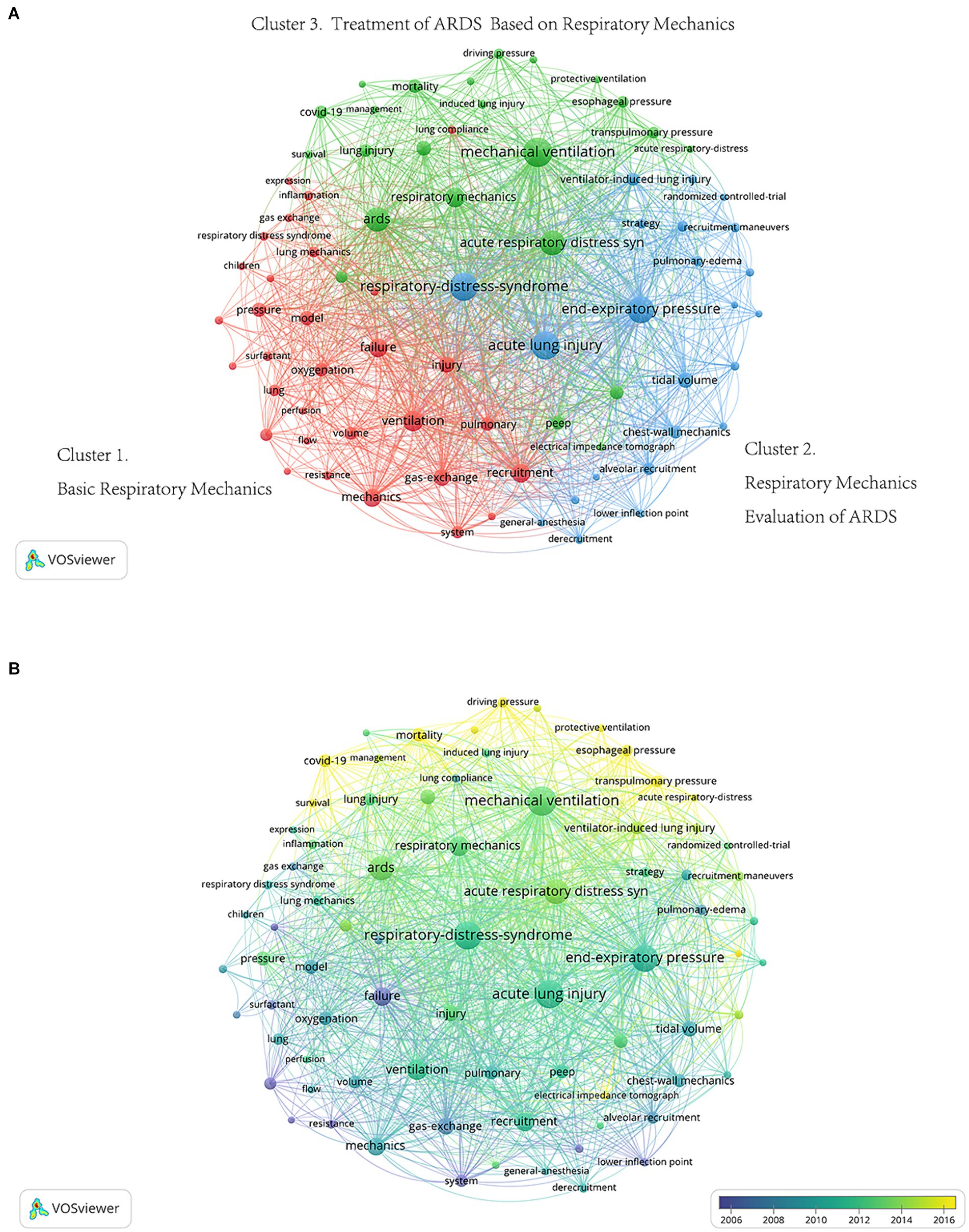
Figure 6. The co-occurrence map of keywords. (A) Co-occurrence network visualization map of keywords. Keywords were divided into three groups: basic respiratory mechanics (bottom left, red), respiratory mechanics evaluation of ARDS (bottom right, blue), and treatment of ARDS based on respiratory mechanics (top, green). (B) Co-occurrence overlay visualization map of keywords. The color of each circle corresponds to the average publication year of the author, the size of a circle is proportional to the total number of occurrences of the keyword, and the thickness of the connecting line indicates the strength of the co-occurrence link.
The co-occurrence overlay visualization map of keywords is shown in Figure 6B. Keywords such as coronavirus disease 2019 (COVID-19) (cluster 3, average publication year 2021), driving pressure (cluster 3, average publication year 2020), protective ventilation (cluster 3, average publication year 2017), transpulmonary pressure (cluster 3, average publication year 2017), electrical impedance tomography (cluster 3, average publication year 2016), and esophageal pressure (cluster 3, average publication year 2016) were the earliest keywords. Based on the color intensity, we found that the research hotspot in ARDS respiratory mechanics research, starting from basic respiratory mechanics, transitioning gradually to the assessment of respiratory mechanics in ARDS, and ultimately shifting toward the treatment of ARDS guided by respiratory mechanics.
Discussion
In the present study, we conducted an exhaustive bibliometric analysis of respiratory mechanics research literature related to ARDS, leveraging the strengths of bibliometric methods to elucidate publication trends, research contributions, and emerging hotspots in the field. By harnessing the power of bibliometric analysis, we aim to provide valuable insights that can inform future research directions and clinical practice in the management of ARDS.
The observed fluctuations in the number of publications over time reflect the dynamic nature of research activity in respiratory mechanics and ARDS. While the number of publications remained relatively stable from 1992 to 2005, research output significantly increased, particularly between 2012 and 2021. The observed increase in publications around 2012 May be attributed to the introduction of the Berlin Definition of ARDS, which aimed to enhance clinical practice and research by offering clear criteria for ARDS diagnosis and classification, leading to an upsurge in scholarly activity focused on ARDS (4). The significant increase in publications observed around 2020 is likely attributed to the global COVID-19 pandemic (29, 30). The unprecedented public health crisis sparked by the emergence of the novel coronavirus led to an intensified focus on respiratory mechanics related to ARDS (31–34).
The dominance of certain countries, such as the United States, Italy, and Germany, in publication output, underscores their significant contributions to the field. The United States has been at the forefront, leading in innovative clinical trials and the development of advanced ventilatory strategies for ARDS management, with the establishment of the ARDS network likely making a significant contribution (9, 10). Italian researchers have made significant strides in understanding the pathophysiology of ARDS, with authors Pelosi P and Chiumello D making particularly outstanding contributions (35, 36). Over the past decade, China has been experiencing a notable increase in its publication output in this domain, mirroring the overall rise in SCI publications in critical care medicine originating from the country (37). Moreover, prolific authors such as Pelosi P and institutions such as the Federal University of Rio de Janeiro have played critical roles in shaping ARDS research through their extensive publications and collaborations. Pelosi P’s influential studies differentiate pulmonary from extrapulmonary ARDS. His research has been fundamental in understanding the unique characteristics and responses to treatment in these patient populations (35). Additionally, his investigations into the effects of prone positioning have provided a deeper understanding of how this technique can improve outcomes for patients with ARDS, underscoring the importance of our focus on respiratory mechanics in our current study (38, 39). The networks among countries and institutions highlight that international collaboration is crucial for advancing ARDS research. It facilitates knowledge exchange and fosters interdisciplinary cooperation (40).
In examining the contributions of journals to respiratory mechanic research related to ARDS, we observe significant variations in publication output and impact. Journals such as Critical Care Medicine, Intensive Care Medicine, and the American Journal of Respiratory and Critical Care Medicine emerge as prominent platforms for disseminating research findings, indicating their pivotal roles in facilitating scholarly discourse and knowledge dissemination. In respiratory mechanics research related to ARDS, the American Journal of Respiratory and Critical Care Medicine typically features studies that concentrate on the underlying pathophysiological mechanisms, associated complications, and the strategic management of patients. The Critical Care Medicine journal tends to present a more comprehensive array of topics, including various treatment approaches, the physiological impacts of the disease, and the general conditions of the illness. In contrast, the Intensive Care Medicine journal often prioritizes in-depth examinations of targeted interventions and the mechanisms at play. Understanding the landscape of journals in respiratory mechanic research related to ARDS is essential for researchers to strategically select suitable publication venues that align with their study objectives and target audiences, ultimately contributing to advancing knowledge in this critical area of medicine.
The co-occurrence analysis of keywords reveals distinct research themes and hotspots within respiratory mechanics research related to ARDS. These include fundamental concepts such as mechanical ventilation and acute lung injury, as well as emerging topics such as COVID-19-related respiratory mechanics and advanced monitoring techniques such as transpulmonary pressure and electrical impedance tomography. Visualizing keyword networks highlights the progression of research focused on basic respiratory mechanics, evaluating and treating ARDS by respiratory mechanics. The co-occurrence overlay visualization map of keywords indicates that researchers’ interest in the respiratory mechanics of ARDS is gradually shifting from basic understanding and treatment of the disease to more detailed and personalized research directions, aiming to understand better and address the complex respiratory mechanics features of ARDS (41, 42).
While this study provides valuable insights into the landscape of respiratory mechanics research related to ARDS, it has some limitations. First, the bibliometric analysis relies solely on data from the WoSCC, which May not encompass all relevant publications in the field. Other databases or sources, such as PubMed or Scopus, could provide additional data not captured in this analysis. Second, the inclusion criteria for selecting articles May introduce bias, as publications in non-English languages were excluded, potentially overlooking valuable research from non-English speaking countries. Furthermore, while co-occurrence analysis provides insights into research trends and hotspots, it does not necessarily imply causation or the true significance of the identified themes.
Conclusion
Over time, there has been a growing focus on respiratory mechanics research related to ARDS, highlighting key topics such as mechanical ventilation and acute lung injury. This study provides valuable insights for future research and holds promise for advancing the treatment and management of ARDS patients.
Data availability statement
The original contributions presented in the study are included in the article/Supplementary material, further inquiries can be directed to the corresponding authors.
Author contributions
Y-MZ: Data curation, Formal analysis, Methodology, Project administration, Software, Writing – original draft, Conceptualization, Investigation, Resources. Y-MW: Data curation, Writing – original draft, Investigation, Methodology. SW: Data curation, Formal analysis, Investigation, Writing – review & editing. Y-LY: Methodology, Writing – review & editing, Formal analysis, Validation. J-XZ: Funding acquisition, Supervision, Writing – review & editing, Validation. LZ: Project administration, Supervision, Writing – review & editing, Validation, Formal analysis, Methodology, Resources. XT: Formal analysis, Methodology, Project administration, Software, Writing – original draft.
Funding
The author(s) declare that financial support was received for the research, authorship, and/or publication of this article. This study is supported by a grant from the Clinical and Research Center program of Capital Medical University (CMU-2023-45).
Conflict of interest
The authors declare that the research was conducted in the absence of any commercial or financial relationships that could be construed as a potential conflict of interest.
Publisher’s note
All claims expressed in this article are solely those of the authors and do not necessarily represent those of their affiliated organizations, or those of the publisher, the editors and the reviewers. Any product that may be evaluated in this article, or claim that may be made by its manufacturer, is not guaranteed or endorsed by the publisher.
Supplementary material
The Supplementary material for this article can be found online at: https://www.frontiersin.org/articles/10.3389/fmed.2024.1420875/full#supplementary-material
Abbreviations
ARDS, acute respiratory distress syndrome; COVID-19, coronavirus disease 2019; IF, impact factor; JCR, journal citation report; PEEP, positive end-expiratory pressure; TC, total citations; TS, topic search; WoSCC, Web of Science Core Collection.
References
1. Ashbaugh, DG, Bigelow, DB, Petty, TL, and Levine, BE. Acute respiratory distress in adults. Lancet. (1967) 290:319–23. doi: 10.1016/s0140-6736(67)90168-7
2. Gattinoni, L, and Pesenti, A. The concept of “baby lung”. Intensive Care Med. (2005) 31:776–84. doi: 10.1007/s00134-005-2627-z
3. Sahetya, SK, Mancebo, J, and Brower, RG. Fifty years of research in ARDS. Vt selection in acute respiratory distress syndrome. Am J Respir Crit Care Med. (2017) 196:1519–25. doi: 10.1164/rccm.201708-1629CI
4. Ranieri, VM, Rubenfeld, GD, Thompson, BT, Ferguson, ND, Caldwell, E, Fan, E, et al. Acute respiratory distress syndrome: the Berlin definition. JAMA. (2012) 307:2526–33. doi: 10.1001/jama.2012.5669
5. Matthay, MA, Arabi, Y, Arroliga, AC, Bernard, G, Bersten, AD, Brochard, LJ, et al. A new global definition of acute respiratory distress syndrome. Am J Respir Crit Care Med. (2024) 209:37–47. doi: 10.1164/rccm.202303-0558WS
6. Slutsky, AS, and Ranieri, VM. Ventilator-induced lung injury. N Engl J Med. (2013) 369:2126–36. doi: 10.1056/NEJMra1208707
7. Katira, BH . Ventilator-induced lung injury: classic and novel concepts. Respir Care. (2019) 64:629–37. doi: 10.4187/respcare.07055
8. Brochard, L, Slutsky, A, and Pesenti, A. Mechanical ventilation to minimize progression of lung injury in acute respiratory failure. Am J Respir Crit Care Med. (2017) 195:438–42. doi: 10.1164/rccm.201605-1081CP
9. Brower, RG, Matthay, MA, Morris, A, Schoenfeld, D, Thompson, BT, and Wheeler, A. Ventilation with lower tidal volumes as compared with traditional tidal volumes for acute lung injury and the acute respiratory distress syndrome. N Engl J Med. (2000) 342:1301–8. doi: 10.1056/nejm200005043421801
10. Brower, RG, Lanken, PN, MacIntyre, N, Matthay, MA, Morris, A, Ancukiewicz, M, et al. Higher versus lower positive end-expiratory pressures in patients with the acute respiratory distress syndrome. N Engl J Med. (2004) 351:327–36. doi: 10.1056/NEJMoa032193
11. Guérin, C, Reignier, J, Richard, JC, Beuret, P, Gacouin, A, Boulain, T, et al. Prone positioning in severe acute respiratory distress syndrome. N Engl J Med. (2013) 368:2159–68. doi: 10.1056/NEJMoa1214103
12. Amato, MB, Meade, MO, Slutsky, AS, Brochard, L, Costa, EL, Schoenfeld, DA, et al. Driving pressure and survival in the acute respiratory distress syndrome. N Engl J Med. (2015) 372:747–55. doi: 10.1056/NEJMsa1410639
13. Cressoni, M, Gotti, M, Chiurazzi, C, Massari, D, Algieri, I, Amini, M, et al. Mechanical power and development of ventilator-induced lung injury. Anesthesiology. (2016) 124:1100–8. doi: 10.1097/aln.0000000000001056
14. Beitler, JR, Sarge, T, Banner-Goodspeed, VM, Gong, MN, Cook, D, Novack, V, et al. Effect of titrating positive end-expiratory pressure (PEEP) with an esophageal pressure-guided strategy vs an empirical high PEEP-Fio2 strategy on death and days free from mechanical ventilation among patients with acute respiratory distress syndrome: a randomized clinical trial. JAMA. (2019) 321:846–57. doi: 10.1001/jama.2019.0555
15. Chen, L, Chen, GQ, Shore, K, Shklar, O, Martins, C, Devenyi, B, et al. Implementing a bedside assessment of respiratory mechanics in patients with acute respiratory distress syndrome. Crit Care. (2017) 21:84. doi: 10.1186/s13054-017-1671-8
16. Grasselli, G, Calfee, CS, Camporota, L, Poole, D, Amato, MBP, Antonelli, M, et al. ESICM guidelines on acute respiratory distress syndrome: definition, phenotyping and respiratory support strategies. Intensive Care Med. (2023) 49:727–59. doi: 10.1007/s00134-023-07050-7
17. Eysenbach, G . Welcome to the journal of medical internet research. J Med Internet Res. (1999) 1:e5. doi: 10.2196/jmir.1.1.e5
18. Cooper, ID . Bibliometrics basics. J Med Libr Assoc. (2015) 103:217–8. doi: 10.3163/1536-5050.103.4.013
19. He, Z, Dai, L, Zuo, Y, Chen, Y, Wang, H, and Zeng, H. Hotspots and frontiers in pulmonary arterial hypertension research: a bibliometric and visualization analysis from 2011 to 2020. Bioengineered. (2022) 13:14667–80. doi: 10.1080/21655979.2022.2100064
20. Lin, GX, Nan, JN, Chen, KT, Sun, LW, Tai, CT, Jhang, SW, et al. Bibliometric analysis and visualization of research trends on oblique lumbar interbody fusion surgery. Int Orthop. (2022) 46:1597–608. doi: 10.1007/s00264-022-05316-1
21. Yao, RQ, Ren, C, Wang, JN, Wu, GS, Zhu, XM, Xia, ZF, et al. Publication trends of research on Sepsis and host immune response during 1999-2019: a 20-year bibliometric analysis. Int J Biol Sci. (2020) 16:27–37. doi: 10.7150/ijbs.37496
22. Sweileh, WM . Patient satisfaction with nursing care: a bibliometric and visualization analysis (1950-2021). Int J Nurs Pract. (2022) 28:e13076. doi: 10.1111/ijn.13076
23. Khan, FR, Raza Kazmi, SM, and Siddiqui, YF. A bibliometric analysis of the studies on dental implant failure. J Pak Med Assoc. (2022) 72:S76–s80. doi: 10.47391/jpma.Aku-15
24. Yildirim, F, Gulhan, PY, Karaman, I, and Kurutkan, MN. Bibliometric analysis of acute respiratory distress syndrome (ARDS) studies published between 1980 and 2020. Adv Clin Exp Med. (2022) 31:807–13. doi: 10.17219/acem/150555
25. Zhang, X, Wang, C, and Zhao, H. A bibliometric analysis of acute respiratory distress syndrome (ARDS) research from 2010 to 2019. Ann Palliat Med. (2021) 10:3750–62. doi: 10.21037/apm-20-2050
26. Wang, C, Wang, X, Long, X, Xia, D, Ben, D, and Wang, Y. Publication trends of research on acute lung injury and acute respiration distress syndrome during 2009-2019: a 10-year bibliometric analysis. Am J Transl Res. (2020) 12:6366–80.
27. Aria, M, and Cuccurullo, C. Bibliometrix: an R-tool for comprehensive science mapping analysis. J Informet. (2017) 11:959–75. doi: 10.1016/j.joi.2017.08.007
28. Van Eck, NJ, and Waltman, L. Software survey: VOSviewer, a computer program for bibliometric mapping. Scientometrics. (2010) 84:523–38. doi: 10.1007/s11192-009-0146-3
29. Wu, Z, and McGoogan, JM. Characteristics of and important lessons from the coronavirus disease 2019 (COVID-19) outbreak in China: summary of a report of 72 314 cases from the Chinese Center for Disease Control and Prevention. JAMA. (2020) 323:1239–42. doi: 10.1001/jama.2020.2648
30. Fan, J, Hambly, BD, and Bao, S. The epidemiology of COVID-19 in the Gansu and Jinlin provinces. China Front Public Health. (2020) 8:555550. doi: 10.3389/fpubh.2020.555550
31. Ranieri, VM, Rubenfeld, G, and Slutsky, AS. Rethinking ARDS after COVID-19. If a “better” definition is the answer, what is the question? Am J Respir Crit Care Med. (2022) 207:255–60. doi: 10.1164/rccm.202206-1048CP
32. Bhatt, A, Deshwal, H, Luoma, K, Fenianos, M, Hena, K, Chitkara, N, et al. Respiratory mechanics and association with inflammation in COVID-19-related ARDS. Respir Care. (2021) 66:1673–83. doi: 10.4187/respcare.09156
33. Somhorst, P, Gommers, D, and Endeman, H. Advanced respiratory monitoring in mechanically ventilated patients with coronavirus disease 2019-associated acute respiratory distress syndrome. Curr Opin Crit Care. (2022) 28:66–73. doi: 10.1097/mcc.0000000000000905
34. Vandenbunder, B, Ehrmann, S, Piagnerelli, M, Sauneuf, B, Serck, N, Soumagne, T, et al. Static compliance of the respiratory system in COVID-19 related ARDS: an international multicenter study. Crit Care. (2021) 25:52. doi: 10.1186/s13054-020-03433-0
35. Gattinoni, L, Pelosi, P, Suter, PM, Pedoto, A, Vercesi, P, and Lissoni, A. Acute respiratory distress syndrome caused by pulmonary and extrapulmonary disease. Different syndromes? Am J Respir Crit Care Med. (1998) 158:3–11. doi: 10.1164/ajrccm.158.1.9708031
36. Chiumello, D, Carlesso, E, Cadringher, P, Caironi, P, Valenza, F, Polli, F, et al. Lung stress and strain during mechanical ventilation for acute respiratory distress syndrome. Am J Respir Crit Care Med. (2008) 178:346–55. doi: 10.1164/rccm.200710-1589OC
37. Liu, J, Zhang, L, and Ma, P. A new era of critical care research in China. J Crit Care. (2019) 54:20–1. doi: 10.1016/j.jcrc.2019.07.005
38. Pelosi, P, Tubiolo, D, Mascheroni, D, Vicardi, P, Crotti, S, Valenza, F, et al. Effects of the prone position on respiratory mechanics and gas exchange during acute lung injury. Am J Respir Crit Care Med. (1998) 157:387–93. doi: 10.1164/ajrccm.157.2.97-04023
39. Pelosi, P, Brazzi, L, and Gattinoni, L. Prone position in acute respiratory distress syndrome. Eur Respir J. (2002) 20:1017–28. doi: 10.1183/09031936.02.00401702
40. Vieira, ES . International research collaboration in Africa: a bibliometric and thematic analysis. Scientometrics. (2022) 127:2747–72. doi: 10.1007/s11192-022-04349-y
41. Pelosi, P, Ball, L, Barbas, CSV, Bellomo, R, Burns, KEA, Einav, S, et al. Personalized mechanical ventilation in acute respiratory distress syndrome. Crit Care. (2021) 25:250. doi: 10.1186/s13054-021-03686-3
Keywords: acute respiratory distress syndrome, respiratory mechanics, mechanical ventilation, bibliometric analysis, international collaboration
Citation: Zhou Y-M, Tian X, Wang Y-M, Wang S, Yang Y-L, Zhou J-X and Zhang L (2024) A bibliometric analysis of respiratory mechanics research related to acute respiratory distress syndrome from 1985 to 2023. Front. Med. 11:1420875. doi: 10.3389/fmed.2024.1420875
Edited by:
Zhongheng Zhang, Sir Run Run Shaw Hospital, ChinaReviewed by:
Feng Shen, Affiliated Hospital of Guizhou Medical University, ChinaShanzun Wei, Second Affiliated Hospital of Nanchang University, China
Copyright © 2024 Zhou, Tian, Wang, Wang, Yang, Zhou and Zhang. This is an open-access article distributed under the terms of the Creative Commons Attribution License (CC BY). The use, distribution or reproduction in other forums is permitted, provided the original author(s) and the copyright owner(s) are credited and that the original publication in this journal is cited, in accordance with accepted academic practice. No use, distribution or reproduction is permitted which does not comply with these terms.
*Correspondence: Linlin Zhang, YWJsdWVsZW1vbkAxNjMuY29t; Jian-Xin Zhou, emhvdWp4LmNuQGljbG91ZC5jb20=
†These authors have contributed equally to this work and share first authorship
 Yi-Min Zhou
Yi-Min Zhou Xiuli Tian2†
Xiuli Tian2† Yu-Mei Wang
Yu-Mei Wang Jian-Xin Zhou
Jian-Xin Zhou Linlin Zhang
Linlin Zhang